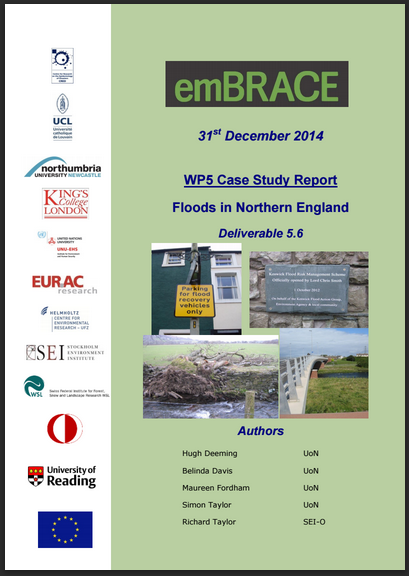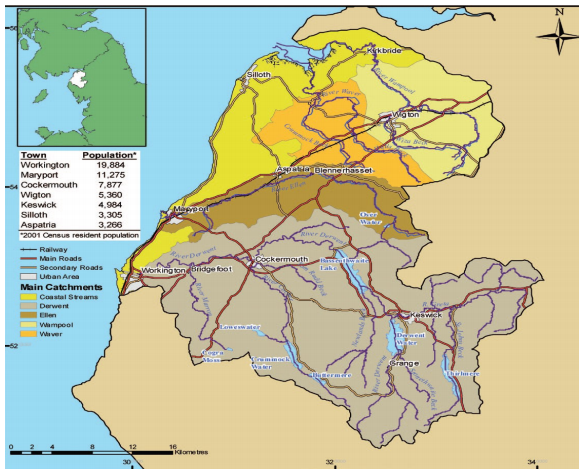Floods in Northern England, UK – emBRACE case study

emBRACE

This case study is part of the emBRACE project. In an interdisciplinary, socially inclusive and collaborative context, emBRACE aims to improve the framing of resilience in the context of disasters in Europe. The primary aim of the emBRACE project is to build resilience to disasters amongst communities in Europe. You can read more about the project here.
Introduction
This study was carried out with the participation and assistance of members of a complex amalgamation of geographical, interest and practice communities situated along the catchment of the River Derwent in the county of Cumbria, north England. The focus of the research was on understanding community resilience to hi-magnitude floods, because parts of this catchment have experienced at least two such events since 2005.
Context of the case study – Cumbria, north England
The population of Cumbria has experienced considerable adversity in the face of a range of hazards and threats1 during the last 13 years. For example, the county was at the forefront of the Foot and Mouth disease crisis in 2001, which decimated local cattle herds and sheep flocks over a wide area as well as severely impacting the wider community and tourist industry (Convery et al., 2008). Further, in June 2010 local resident, Derrick Bird, murdered twelve people and injured a further eleven in a shooting spree (Chesterton, 2011). The county, has also, however, experienced repeated high-magnitude floods over this period, which have caused damage and disruption across the county and generated much press attention across the UK. All these events are still raw in the memory of residents and emergency services’ staff, but whilst the wider experience of tragic events provides important context for any investigation of resilience in the county, this case-study focused primarily on understanding the relationship between the studied communities and flood hazards.
The floods that occurred in January 2005 and November 2009 are the most recent examples of extreme flooding in Cumbria. Several towns, villages and rural areas were affected in 2005, with Carlisle experiencing ~3,500 homes flooded and considerable disruption to energy and communications infrastructure (Cumbria County Council, 2005). The 2009 floods are the focus of this research. This event caused significant damage across Cumbria, but most notably along the Derwent River Catchment, as it flows from its watershed in Borrowdale and St John in the Vale, through the towns of Keswick and Cockermouth and to Workington and the sea.

The River Derwent Catchment
Methodology
This case study was conducted using a mixed methodology, which included interviews, workshops and social network analysis. The fieldwork was conducted over the period of approximately one year, between July 2013 and July 2014, with the research being carried out by a team of UoN staff. Sixty-five interviews were completed using a snowball sampling method.

Keswick Flood Wall.
Summary and Conclusions
Investigating ‘community’ resilience to natural hazards along a short river catchment presents problems of quantification and qualification. The very question “which community are we talking about?” revealed there to be any number of population groups who could be categorised as bearing an interest. Flood impacts along the course of the catchment varied. The inundation of fertile pasture meant that farmers in the high catchment saw their, already multiply-stressed, businesses placed under further strain, whilst townspeople and businesses further downstream also experienced devastating damage to their homes, livelihoods and psychological security.
Key messages
– The research confirmed the complex mix of resource and capacity sets that comprise the core of community disaster resilience. While civil protection dimensions remain key facilitators, they cannot effect fully resilient outcomes unless developed in concert with the broader social protection objectives and alongside a cohort of engaged community members and professional ‘brokers’.
– Key factors in determining how resilient the households, businesses and communities were relative to each other, included the presence and engagement of ‘resourceful’ individuals (within the community itself or as enablers working within community-facing organisations), but also place-based factors such as the availability of a formal warning systems and loss-sharing mechanisms.
– This report has corroborated the understanding that, even in the close spatial confines of a short river catchment, different geographical communities need to access and utilise different resource sets and capacities to maintain their resilience to hazards.
Other
Citation:
Deeming, H., Davis, B., Fordham, M., Taylor, S., and Taylor, R., (2015) Case study report: Floods in Northern England, Deliverable 5.6, emBRACE project
(0) Comments
There is no content